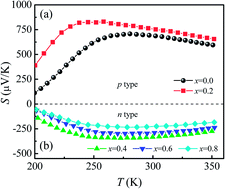Carrier type change induced by fluorine doping in spin-chain compound Ca3Co2O6
Abstract
The structural, magnetic, electrical, and thermoelectric properties of fluorine (F)-doped Ca3Co2O6 were investigated systematically. Based on the use of X-ray diffraction, X-ray photoelectron spectroscopy spectra, and magnetic data, it was concluded that part of the Co3+ ions at octahedral sites would transfer into Co2+ because of the substitution of F− for O2−. The induced Co2+ ions are antiferromagnetically coupled with the nearest neighboring Co3+. The room-temperature resistivity decreases monotonously with the increase of fluorine (F)-doping content, x, and it is suggested that this is related to the increased carrier mobility. The resistivity curves of the samples with x ≥ 0.4 show an anomaly at T* ∼ 320 K, which is considered to be related to the change of activation energy (Ea). The room temperature thermopower S300 K changed from a positive value of 686.6 μV K−1 to a negative value of −333.1 μV K−1 as x increases from 0 to 0.4 and considering this with the Hall coefficient result, it is concluded that suitable F-doping in Ca3Co2O6 can change the type of the majority of carriers from p to n with a decreased resistivity. The thermal conductivity, κ of the n-type samples is much larger than that of the p-type, and the κ of both the p-type and n-type samples decreases monotonously with increasing x. The anomaly of κ near x = 0.4 is suggested to originate from the decreased grain boundary scattering and the sudden decrease of Ea at the critical point of the carrier type change.


 Please wait while we load your content...
Please wait while we load your content...